Search results for: 'glas'
-
 Core-formed glass alabastron
Core-formed glass alabastronColourful example from the beginning of glass manufacturing in ancient Greece. Glass vessels like this were manufactured on the island of Rhodos during the 5th century BC.
€1,850 Alabastron from colourful core-formed glass
Alabastron from colourful core-formed glassColourful example from the beginning of glass manufacturing in ancient Greece. Glass vessels like this were manufactured on the island of Rhodos during the 5th and 4th century BC.
€3,140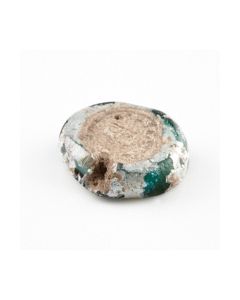 Rare Roman mosaic glass face bead showing Medusa head
Rare Roman mosaic glass face bead showing Medusa headMosaikglasperle aus einer oströmischen Werkstatt des 1. Jh. n. Chr., möglicherweise ägyptisch oder nubischer Import. Das abgebildete Frauengesicht wird gerne als Darstellung der Medusa gedeutet.
€490 Core-formed glass juglet
Core-formed glass jugletThe brown glass with a decorative wave pattern imitates the shape of a Greek metal or pottery hydria, but without the handles at the sides. A nice example for the early glass production in Greek to Hellenistic times.
€2,080 Phoenician glass head pendant
Phoenician glass head pendantPolychrome glass jewellery with a plastically moulded face of a woman. A product from the Phoenician culture, created around 400 BC.
€1,800 Mosaic glass inlay with half mask
Mosaic glass inlay with half maskSkillfully arranged motif that could be combined with a plate of the same motif to show a full face. Made in Egypt during the early Roman Imperial period.
€4,700 Phoenician glass head pendant
Phoenician glass head pendantPolychrome glass jewellery with a plastically moulded face of a woman. A product from the Phoenician culture, created around 400 BC.
€2,800 Phoenician glass head pendant
Phoenician glass head pendantPolychrome glass jewellery with a plastically moulded face. A product from the Phoenician culture, created around 400 BC.
€2,500 Roman glass mosaic bowl
Roman glass mosaic bowlNice little bowl with mosaic glass eyes on blue and green background. Exhibited and published in the 1980ies. Made in the early Roman Imperial period in the province of Syria.
€15,500 Egyptian glass inlay in face shape
Egyptian glass inlay in face shapeThe flat relief made of red glass paste served as an inlay and decorative element in the Ptolemaic period. It was combined with a headgear and body inlay.
€8,900 Two mosaic glass beads
Two mosaic glass beadsNicely decorated miniature works of art. Outstanding examples for mosaic glass beads from the early Roman Imperial period.
€1,240 Three mosaic glass beads
Three mosaic glass beadsMiniature works of art with different decorations. Fantastic examples for mosaic glass beads from the early Roman Imperial period.
€1,670 Mosaic glass inlays and spindle whorls
Mosaic glass inlays and spindle whorlsNice group of polychrome inlays and spindle weights from Roman Egypt. Including two fragments with a wonderful floral decor.
€870 Roman-Egyptian glass inlays and spindle whorls
Roman-Egyptian glass inlays and spindle whorlsNice group of polychrome inlays and spindle weights from Roman Egypt. From an old English collection, ex Bonhams London.
€610 Core-formed polychrome glass alabastron
Core-formed polychrome glass alabastronNice and small vessel with a strong patina. It is not a classical type of alabastron and retains a few mysteries.
€755 Mosaic glass inlays and spindle whorl
Mosaic glass inlays and spindle whorlNice group of polychrome inlays and a spindle weight from Roman Egypt. Including one fragment with a wonderful floral decor.
€950 Mosaic glass inlays and spindle whorls
Mosaic glass inlays and spindle whorlsNice group of polychrome inlays and spindle weights from Roman Egypt. Including one fragment with a wonderful floral decor.
€950 Roman glass bottle with beautiful colour bands
Roman glass bottle with beautiful colour bandsA colourful ancient glass from the early 1st century. Made in the Eastern Mediterranean.
€4,650 Necklace of Egyptian mosaic glass beads
Necklace of Egyptian mosaic glass beadsModernly threaded necklace of ancient beads of spherical and cylindrical shape made of beautiful mosaic glass. From a workshop in Roman Egypt. Ex Christie's.
€5,100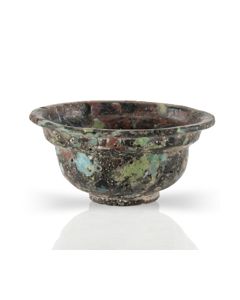 Roman glass mosaic bowl
Roman glass mosaic bowlNice little bowl with an abstract colourful design. Dating to the early Roman Imperial period. With Italian export permit.
€3,450 Roman bowl of colourful ribbon glass
Roman bowl of colourful ribbon glassThe bowl was made in mosaic glass technique. It is truely a work of art and a showpiece for the glass production in the Roman core region during the Early Imperial period.
€33,000 Roman marbled glass bowl
Roman marbled glass bowlA beautiful vessel and great example for the high quality glass production during the Early Roman Imperial period. From the 1976 catalogue Muenzen und Medaillen.
€11,000 Necklace of Roman Egyptian mosaic glass beads
Necklace of Roman Egyptian mosaic glass beadsModernly threaded necklace of ancient beads made of beautiful mosaic glass. From a workshop in Roman Egypt. Ex Christie's.
€9,100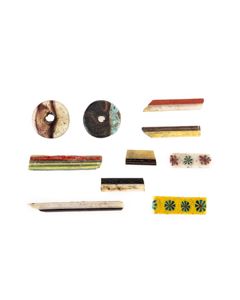 Mosaic glass inlays and spindle whorls
Mosaic glass inlays and spindle whorlsNice group of polychrome inlays and spindle weights from Roman Egypt. Including two fragments with a wonderful floral decor.
€1,180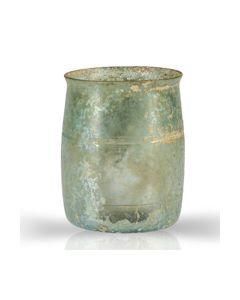 Roman glass beaker
Roman glass beakerBeautiful turquoise glass with incised decorative grooves. From the 1st or 2nd century AD.
€730 Roman glass bowl
Roman glass bowlSmall bowl made of pale turquoise glass, from the Roman Imperial period. Acquired in 1974 at the antiquities gallery Neuhaus.
€460 Roman square glass bottle
Roman square glass bottleTypical and popular glass vessel type from the Roman Imperial period. From the Heckmann collection.
€750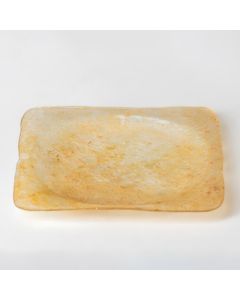
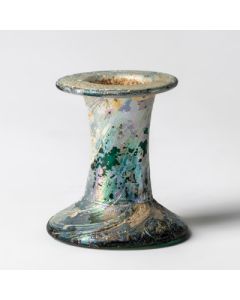 Roman glass
Roman glassBeautifully iridescent turquoise-green glass in a cylindrical shape. From the Roman Imperial period.
€350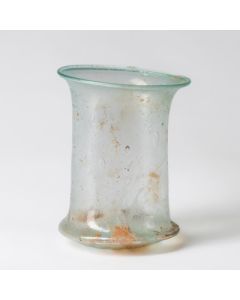 Roman glass beaker
Roman glass beakerRare cup made of almost colourless, slightly turquoise glass. From the 2nd to 4th century AD.
€600 Large Roman cinerary urn
Large Roman cinerary urnImpressive jar from the 1st or 2nd century AD. Great condition for ancient glass of this size. 26cm high.
€4,800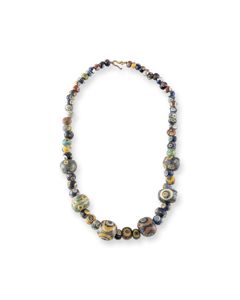 Necklace of large eye beads
Necklace of large eye beadsModernly threaded necklace made of ancient glass beads from around the mid 1st millennium BC in the eastern Mediterranean. Ex Christie's.
€8,400 Group of ancient eye beads
Group of ancient eye beads10 magnificent polychrome glass beads with stylized eyes as protection against the evil eye. Made around the mid 1st millennium BC in the eastern Mediterranean. Ex Christie's.
€2,100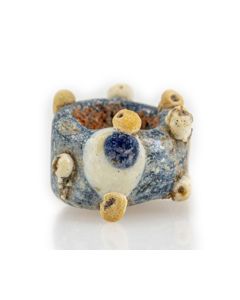 Phoenician eye bead
Phoenician eye beadPolychrome glass bead with stylized elements of a face as protection against the evil eye. Produced in Carthage or the Phoenician homeland, 4th to 3rd century BC.
€310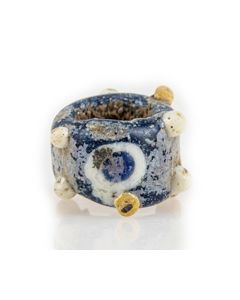 Phoenician eye bead
Phoenician eye beadPolychrome glass bead with stylized elements of a face as protection against the evil eye. Produced in Carthage or the Phoenician homeland, 4th to 3rd century BC.
€300 Phoenician eye bead
Phoenician eye beadPolychrome glass bead with stylized elements of a face as protection against the evil eye. Produced in Carthage or the Phoenician homeland, 4th to 3rd century BC.
€250

